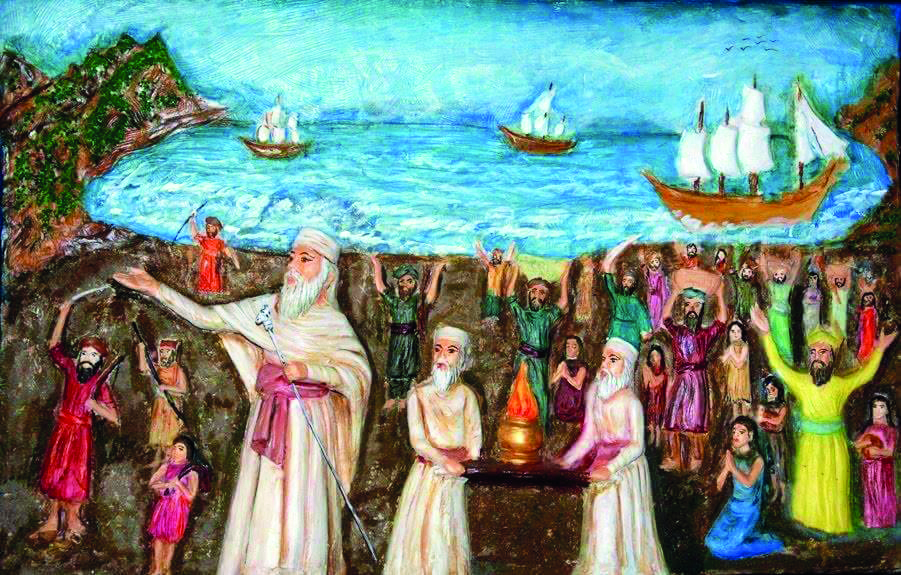Parsi Times presents a 4-part series by Adil J. Govadia, which explains the different grades of our Holy Fires and their crucial importance in our religion and our lives.
 Nature’s four elements – Earth, Water, Air and Fire, play an essential role in the life of a Zoroastrian, particularly Fire, which is a predominant element, considered to be the foundation of the universe. Therefore, it is important to first understand the import of Fire in Zoroastrianism and its occult significance.
Nature’s four elements – Earth, Water, Air and Fire, play an essential role in the life of a Zoroastrian, particularly Fire, which is a predominant element, considered to be the foundation of the universe. Therefore, it is important to first understand the import of Fire in Zoroastrianism and its occult significance.
In the Avesta, Adar is described as a Yazata (spiritual being) who presides over fire and referred to as, ‘the son of Ahura Mazda’. (Likewise, in the Ushtavad Gatha (45:4) and in the Vendidad (Fargard 19:13) Spendarmad Ameshaspend is referred as the ‘daughter of Ahura Mazda’ while in Yasna Haptanghaiti (36:6) the Sun is referred as ‘the most beautiful body of God’.)
It is through this Spiritual Being that a Zoroastrian offers his prayers to the creator Ahura Mazda. This figure of speech is only intended to accentuate the significance of Fire, which, in Zoroastrianism, is not only God’s most significant creation but also the physical manifestation of Divinity (Ref. Jal Rustamji Vimadalal ‘What A Parsee Should Know’).
Fire was also referred as ‘dushman jadaar’ or striker of the enemy, which during the Sassanian period got renamed as ‘Bahr-ram’ or ‘Behram’ (angel of victory)! Thus, the word ‘Atash Behram’, meaning ‘the fire victorious’ in whose proximity no opposing artificial light or electricity is permitted – be it the light bulb, camera flash, torch or mobile phone. Hence there’s no electricity around the sanctum sanctorum of all Atash Behrams, with mobile phones and photography strictly prohibited.
The word ‘Atash’ in Zoroastrianism refers to all types of fire energies in nature, including heat resulting from combustion, electricity, lightning, thermal, nuclear etc. It’s therefore imperative to recognize various Fire energies and their status in nature, as worship of Atash in Zoroastrianism is one of the seven foundational pillars, besides Asha (the founding principle of Zoroastrianism), Boonak Pasbani (preservation of racial purity), Dokhmenishini (disposal of the dead by exposure to sunlight), Kriya-kaam (spiritual importance of rituals and ceremonies), Manthravani (sacred vibratory invocations), and Sudreh-Kusti (talismanic spiritual implements).
At the beginning of Creation, Ahura Mazda created nine spiritual fires – Adar Gushasp (manifested in the times of King Kay Khushro); Adar Khordad (manifested in the times of King Jamshed); Adar Burzin-Mehr (brought to King Vistasp’s court by Prophet Zarathushtra); Atash Berzi-savangh (invisible but shining in the spiritual realms of Ahura Mazda and the Ameshaspends); Atash Vohu-friyan (present in the body of man and animals); Atash Urvazisht (present in plants and vegetation); Atash Vazisht (lightning fire); Atash Spenisht (fire produced through friction); and Atash Nairyosangh (fire present in the body of the Kings and great ones).
While each of these fires has its own significance in the universe, it is important to understand the significance of consecrating fire in a given Fire Temple and its link with various fire energies, on various spiritual planes in nature. However, the first three fires mentioned above belong to the three estates, that is the Athravan (priest), the Rathaeshtar (warrior) and the Hutokhsh (artisan’s home). (Ref ‘A Guide to the Zoroastrian Religion’ by Dastur Dr. Firoze M. Kotwal and James Boyd).
Parsi-Zoroastrians mainly worship three grades of Fire namely, Atash Behram (highest grade), Atash Adaran (intermediate) and Atash Dadgah (lower grade). Atash Behram, by virtue of its very name, means ‘fire dedicated to victory’, and does not approve artificial light energies to come anywhere near it. In fact, after the last Persian Emperor Yazdegard III was dethroned, the Zoroastrian migrants to India, also called ‘Khorasan-ni Mandali’ – meaning the Congregation from Khorasan, soon decided to honour the vow they had earlier undertaken on high seas to build a fire temple at the first opportune moment.
Thus, two Mobeds (priests) were sent overland to Persia, to undergo Barashnum (spiritual cleansing / ablutions) and bring back the ‘aalat’ (ritual implements) necessary for consecrating the sacred fire. A parcel of land was gifted by the noble Hindu Ruler and work began in right earnest to build and consecrate a high-grade Atash Behram, reputably consecrated in 721 CE by Dasturji Neryosang Dhaval. With his manthric powers, Dasturji Neryosang Dhaval made lightning strike on a log of sandalwood which was then included in the consecration process. Originally the Holy Fire at Sanjan was referred to as ‘Sanjanawala-na Atash Behram’ or ‘Puratan Atash Behram’ (The Old Atash Behram); it was much later that the present name IRANSHAH was adopted in the Persian text of the ‘Qissa-e-Sanjan’ (Ref. Dastur Dr. Firoze M. Kotwal’s ‘A Historical Overview of the Parsi Settlement in Navsari’)
NOTE: Many lay Parsis misguidedly believe that a Persian Fire was physically carried on boats at the time of mass migration sometime in late 7th century which was later enthroned in Sanjan as Iranshah Fire. This is an incorrect belief as consecrated fire cannot be transported over the sea route.
